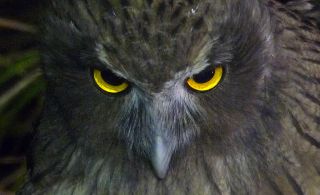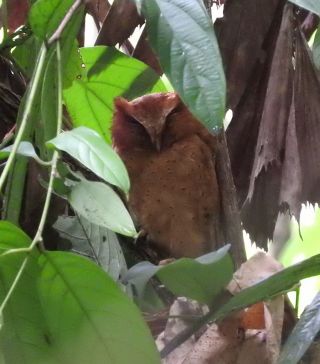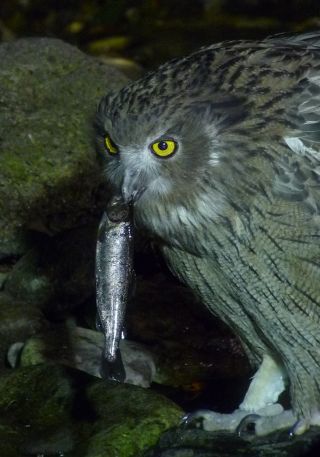The doubly eponymous Blakiston's Fish Owl Bubo blakistoni
Wild Watch New Beginnings: An E in Natural History
By Mark Brazil | Apr 10, 2015
The power, persistence and penetrative capacity of a tropical downpour have to be witnessed first hand to be believed. Darkening thunderclouds billow and swirl up above the horizon until they stretch across the entire view turning leaden as they expand. Thunder crashes and rolls around the hills so vigorously that primitive beliefs in angry gods doing battle in the heavens suddenly seem quite understandable. Reverberations roll on and on, crashing, seemingly endlessly, against the hills like storm waves crashing onto a beach – never quite in a rhythm, yet somehow soothing despite their immense power.
As I write, I am looking out through the open shutters (no glass in these windows) of a small, storm-shaded simple room at Martin’s Lodge beside Sinharaja Reserve. Deeply overhanging corrugated iron eaves funnel the torrential rain that pounds down on to the roof out towards the glossy-leaved forest edge. On one side, the one nearest my window, the forest stands lush, tall and close up against the building; the forest looms like a living green wall. Just around the corner and down slope are trademark elements of a local tropical home garden: a forest clearing with coconut palms and a few banana palms providing shade for several ranks of tea bushes stunted by regular pruning and plucking. Around the plot a range of tropical spice and fruit trees (cloves, mango, guava and orange) provide further edible diversity, through which a family party of wild Sri Lankan Junglefowl is steadily foraging, kicking aside and turning over the slowly rotting leaf litter in search of invertebrates living in the topsoil.
This is Sri Lanka, a friendly, welcoming tropical island where, for the last month, Mayumi and I have been soaking up the country’s natural history delights ranging from delicate Tree Nymph butterflies (I’ve personally dubbed them Tissue-paper Butterflies because they waft so erratically and gently through the air that they resemble scraps of the finest tissue) in the glades and clearings within hill top tropical forest to the leviathan Blue Whales that cruise the depths of the Indian Ocean just off the island’s southern coast and give whale watchers tantalizing glimpses as they wallow briefly at the surface breathing heavily before raising their flukes in a magnificent wave before returning to the depths once more. This is a wondrous island for any travelling naturalist, but for me the lush green of this island, once called Serendib by Arab traders, provides a warming and welcoming change from the drab tag-end of winter that our home island of Hokkaido currently offers.
Today began bright and clear-skied. For the first couple of hours walking in the forest was pleasant and accompanied by a resounding chorus of frogs and occasional birds. Occasionally loud, morning whoops from troupes of Purple-faced Langurs disturbed this relative quiet, but the morning’s warmth built quickly to a strength-sapping heat that caused bird and mammal activity to drain away, but was ideal for butterflies and soon had the sound of the local cicadas drilling their way into my brain. Within hours cloud built up, at first it provided pleasant and moderately cooling shade, but then it threatened a significant change in conditions. Thanks to the dramatic storm that the build up spawned, it is now almost as dark as night despite it being only four in the afternoon. It reminds me somewhat of typhoon season in Okinawa, though without that season’s battering winds and horizontal rain. Here in Sri Lanka the rain falls vertically, in seemingly solid stripes like Victorian stair rods with a pale constancy against the darkness of the forest foliage.
Rivulets of water have washed away any hint of dust. The downpour has freshened the air and brought a further hint of coolness to the barest breath of a breeze. It feels almost as cool as dawn again and coolness prompts thoughts.
Sri Lanka is a marvellous country in which to enjoy the fruits of an ancient civilization dating back to the 5th century BC while also pursuing natural history interests. One finds ancient sites and nature reserves in close proximity and because of this small island’s diverse topography and wide range of habitats it boasts impressive lists of a wide range of life forms. A mere 435 km (270 miles) from north to south and only 225 km (140 miles) from east to west at its widest point, this teardrop-shaped island at 65,610 square kilometers (25,332 square miles) is only a little larger than West Virginia in the USA, and quite noticeably smaller than Austria in Europe or Hokkaido in Japan. Despite its small size it no doubt still hides natural history secrets – after all a new species of owl, the Serendib Scops Owl was discovered there as recently as 2001. I count myself very fortunate on two accounts, as I have seen it twice in the last five years, once just days ago, and I have also met its discoverer Deepal Warakagoda the renowned ornithologist and senior author of the finest avian field guide to the island: Birds of Sri Lanka. Sheltering amidst the dense shade of epiphytic growth on a Fish-tailed Palm trunk, this remarkable species that had remained unknown to scientists, naturalists and local Serendibians alike through centuries of exploration, dozed quietly at its day roost. It seemed to both exemplify the fractal nature of our world, so much of which remains hidden from us, and the remoteness of places seemingly so close.
Generations of fiercely motivated naturalists have been driven into remote parts of the world, to what were once considered far flung islands or to isolated mountain ranges and isolated pockets of extraordinary habitats, in search of the new and outlandish in terms of butterflies, beetles, birds and all other forms of life. Theirs was the quest if novelty, to find, to describe and to name new species. However, as Fredrik Sjöberg has described in his wonderful book The Fly Trap: “As long as there have been biologists, they have sought out islands to keep profusion from making them crazy.” They have sought “islands”, pockets of different habitat surround by others, inside which isolation has driven the evolution of unique forms in almost nameless numbers. Somehow though, naming a thing breeds in us a confidence that we have moved partway towards understanding that thing. So far we naturalists and scientists have logged the names of some two million things, but we estimate that there may be closer to 10-100 million living “things” to know. But knowing the name of a thing actually brings us little closer to understanding it than our ability to recite the name of a sutra does to making us the reincarnated Buddha, or knowing the name of either the Bible or Koran brings us closer to understanding fully the contents of those holy books. Nevertheless, knowing their names, recognizing their relationships, then learning their habits and building up a broader picture of them – in a way learning to read the natural landscape – is a ceaseless activity for those of us with a fascination for learning the language of the natural world.
The development of the concise Linnaean form of naming species has been crucial in allowing more of us to read the natural landscape. In modern parlance we might call this 18th century advance as crucial an operating system for biologists as iOS was for Apple computer, iPhone and iPad users or Windows is for PC users. This system involves using a first, or generic, name followed by a second, or specific, name; convention dictates that both are written in italics (though many popular publications ignore this valuable convention). This naming system, pioneered by the physician, botanist and zoologist Carl Linnaeus (1707-1778) born in Stenbrohult parish, southern Sweden, took hold in the first half of the 18th century, and replaced the older convention of longer and typically somewhat rambling Latin descriptions.
It was Linnaeus who established a hierarchical structure for the classification of living organisms, which in his day, and until recently was a classification based on observable characteristics. Today the analysis of DNA is a remarkable new weapon in the scientist’s arsenal allowing us to further understand and refine the relationships between living things.
Linnaeus’s system for naming species not only shook up the scientific establishment but also swept the world. It is the only way that scientists from around the globe can be sure they each grasp what the other is talking about when it comes to our Earth’s basic biological units – species. It seems so obvious to us now, but prior to the development of the new taxonomic and naming system, the names of species had essentially consisted of long descriptive passages written in the no longer living language of Latin. It was hardly practical for the budding entomologist, mammalogist or ornithologist whose quarry would no doubt long have moved on before such a naturalist could have described it in detail. The old naming system was perhaps less critical for botanists who could rely on their study species staying put, yet they too have embraced the new naming system fully. The brevity of the new system was its genius and its winning feature over the older more cumbersome “operating system”, and of course, as its pioneer, Linnaeus was in the position to give names, using his new binomial system, to more than 12,000 species ranging from Parnassius apollo (the beautiful Apollo Butterfly) to Grus grus (the Common Crane) and Ursus arctos (the Brown Bear).
Today, the secret dream of every naturalist is to discover a new species for science or to receive the highest accolade in having one named after them. The former is more frequently accomplished by entomologists these days than by any other “oligist.” Personally I have met only two people after whom species have been named: Sir David Attenborough, who has been rewarded with numerous species named for him, and Dr Angela Kepler, after whom the Elfin-woods Warbler of Puerto Rico (discovered in 1968 and described in 1972) was named Setophaga angelae.
Naming is a wonderful way of acknowledging the important role someone has played either in conservation, science, or as inspiration (family member, wife, mistress, mentor, sponsor, teacher etc). In the case of the Serendib Scops Owl of Sri Lanka it was named Otus thilohoffmanni to honour the late Thilo Hoffmann who was president of the Ceylon Bird Club and chairman of the A. Bauer Company to acknowledge his leadership in campaigning during the 1970s to conserve the Sinharaja Rainforest and protect it against logging. While most naming reflects the namers respect for the person commemorated it is not always the case. Carl Linnaeus himself was not averse to applying names critically. He had a dislike for the French naturalist Buffon and took matters into his own hands by using an eponym and naming an insignificant weed Buffonia after him. It is an urban myth that he named the ugly Common Toad bufo after him as a derogatory joke, but the Romans already used that name in Latin long before Buffon’s time.
Species may also be named for a prominent feature, perhaps a colour in their coat, plumage, flowers or fruit, after a geographical location where they are found, or where they were first recorded, or, in the case of eponymous species after a prominent person. Eponymous, if you haven't already realised is my E in Natural History. You’d be amazed at the kind of people who have been commemorated (eponymised?), from David Attenborough to Wolfgang Amadeus Mozart, from Bono to Mick Jagger, from Kate Winslet to Arnold Schwarzenegger, from Nelson Mandela to Donald Rumsfeld and even Adolf Hitler.
Japan has its fair share of eponymous species in just about every branch of natural history. In spring we are treated to the delightful blooms of Siebold’s Magnolia, while in winter the stark grey trunks of Erman’s Birch Betula ermani are beautiful against snow-covered mountain slopes. Among the birds we have the spectacular fish owl of Hokkaido, named after the British captain Thomas Wright Blakiston once resident in Hakodate and after whom Blakiston’s Line is also named. The fish owl rather unusually carries his name in both scientific and common names, thus it is known as both Blakiston’s Fish Owl and Ketupa blakistoni. At the opposite end of the country, in Okinawa, we have the doubly eponymous woodpecker species known as Pryer’s Woodpecker in English, named after Pryer, a Yokohama-based contemporary of Blakiston to naturalists and to scientists as Dendrocopos noguchii after the otherwise poorly known Japanese collector.
Words and names though an important window onto the natural world, have a fascination all of their own. Did you know for example that the shortest scientific name of all consists of just four letters? It is that of a species of bat, known as Ia io. While the longest generic name I have found consists of 31 letters and is that of a fossil dragonfly known as Kimmeridgebrachypteraeschnidium.
A word for which I have searched for many years amongst my colleagues is that used to describe species for which the taxonomic binomial consists of two identical words, that is both the generic and specific names are the same. None of the dozens of scientists and naturalists I have asked have known it. Then, by pure chance, while checking facts for this article I came upon the wonderful term I have been looking for, and it is tautonym. Interestingly such tautonymic names are not allowed by rules of botanical nomenclature, but animals are exempt, thus we have Bison bison (Bison), Troglodytes troglodytes (Northern Wren), Pica pica (Common Magpie) and so on. The shortest tautonym is Loa loa (a nematode worm), while the longest is Icelanonchohaptor icelanonchohaptor (a flatworm). When subspecies are recognised we even have trinomials, and these too can by tautonymous, some relatively short such as Bufo bufo bufo (the European Toad, sadly not named after Buffon), Naja naja naja (the cobra), but with a record-breaking 36-letter long trinomial Coccothraustes coccothraustes coccothraustes (the Hawfinch). The humour of scientists is perhaps not often enough considered, but how marvellous for someone to have named a tiny marine gastropod mollusc Ittibittium. These are smaller than molluscs of the genus Bittium; and we even have one here in Japan: Ittibittium nipponkaiense, which, despite sounding more appropriate as a chorus line for a country and western song, is now my favourite scientific name.
If taxonomy, and the naming of things should interest you, then I highly recommend that you delve into the delights of a website that goes by the title: www.curioustaxonomy.net
Outro
Author and naturalist Dr Mark Brazil contributed his Wild Watch column to The Japan Times newspaper for 33 years. A collection of Mark’s essays The Nature of Japan has recently been published and is available from Japan Nature Guides. From this month Wild Watch moves to its new home here on the Japan Nature Guides website www.japannatureguides.com. All articles dating back to 1999 are archived here too for your reading pleasure.
(c) Mark Brazil 2015



